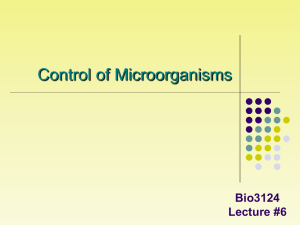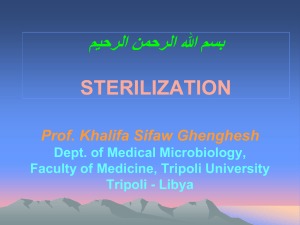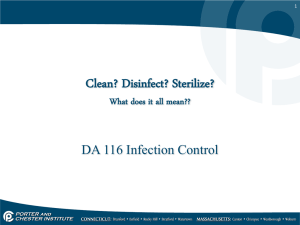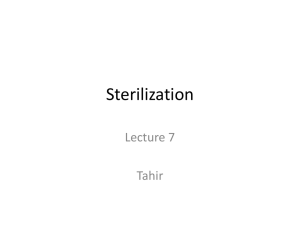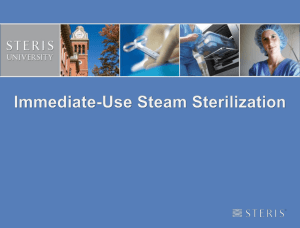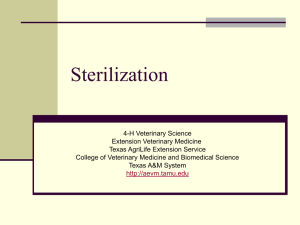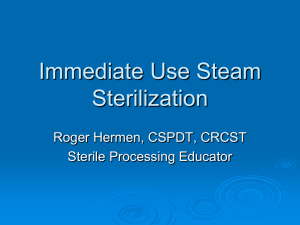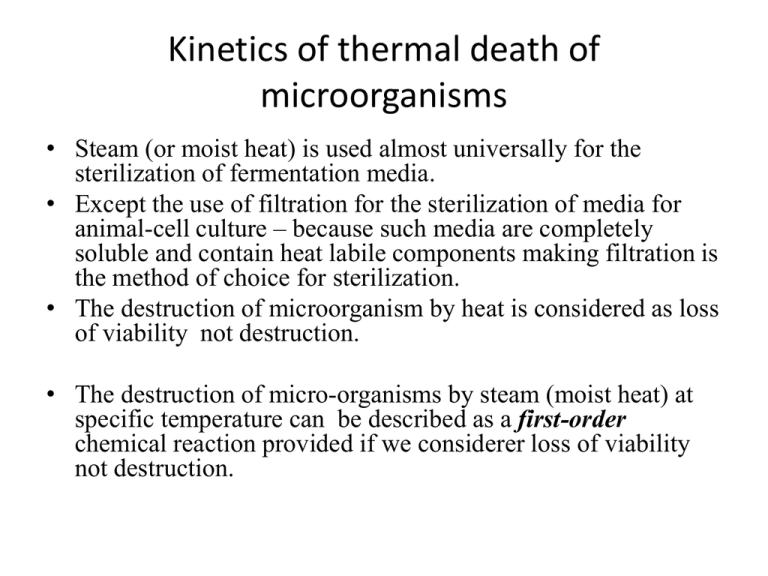
Kinetics of thermal death of
microorganisms
• Steam (or moist heat) is used almost universally for the
sterilization of fermentation media.
• Except the use of filtration for the sterilization of media for
animal-cell culture – because such media are completely
soluble and contain heat labile components making filtration is
the method of choice for sterilization.
• The destruction of microorganism by heat is considered as loss
of viability not destruction.
• The destruction of micro-organisms by steam (moist heat) at
specific temperature can be described as a first-order
chemical reaction provided if we considerer loss of viability
not destruction.
•
•
The thermal death kinetics may be represented by the following equation:
-dN/dt = kd N
1
• Where,
– N, is the number of viable organisms present,
– T, is the time of the sterilization treatment
– kd, is the reaction rate constant of the reaction,
or the specific death rate per time.
On integration of equation (i) from t=0’ to t=t,we have the following expression :
Nt/N0 =e-kdt
•
2
where
– No is the number of viable organisms present at the start of the sterilization treatment,
– Nt is the number of viable organisms present after a treatment period, t.
On taking natural logarithms, equation (2) is reduced to:
ln(Nt/N0) = - kd t
3
The graphically equations (1) and (3) are represented as,
Fig: Plots of the proportion of
survivors and the natural logarithm
of the proportion of survivors in a
population
of
microorganisms
subjected to a lethal temperature
over a time period.
The relationship observed in the above graph would be found only with the
sterilization of a pure culture in one physiological form, under ideal sterilization
conditions.
From Principles of Fermentation
Technology,- Peter F. Stanbury,
Allen Whitaker, Stephen J. Hall,
Second Edition,
We have got two predictions from this kinetic description-
– (i) An infinite time is required to achieve sterile
conditions (i.e. Nt= 0).
– (ij) After a certain time there will be less than one
viable cell present.
• The ratio of No/Nt is the inactivation factor,
• The ratio of Nt/No is the survival factor and
• the In of No/Nt=V is the design criterion, a
parameter which encompasses the
contamination level of the medium to be
sterilized, No, and the desired sterility level,
Nt.
• In the above equations,
– k is a constant which expresses the specific death
rate.
– It increases sharply with temperature and
– can be experimentally determined far an organism
using equation 3.
If the experimentally determined Ink value from
this equation is plotted against the reciprocal
temperature (1/T) value, a straight line should be
obtained from which the k value can be
calculated for a desired temperature.
The value of k is not only species dependent, but
dependent on the physiological form of the cell
(i.e. vegetative and spore form)
Initial population increase resulting from the heat activation
of spores in the early stages of a sterilization process
From Principles of Fermentation
Technology,- Peter F. Stanbury,
Allen Whitaker, Stephen J. Hall,
Second Edition,
An initial stationary period observed during a sterilization
treatment due to the death of spores being completly compensated
by the heat activation of spores
From Principles of Fermentation
Technology,- Peter F. Stanbury,
Allen Whitaker, Stephen J. Hall,
Second Edition,
Initial population decline at a sub-maximum rate during a sterilization
treatment due to the death of spores being compensated
by the heat activation of spores
From Principles of Fermentation
Technology,- Peter F. Stanbury,
Allen Whitaker, Stephen J. Hall,
Second Edition,
The effect of a sterilizaIion treatment on a mixed culture consisting of a
high proportion of a very sensitive organism
From Principles of Fermentation
Technology,- Peter F. Stanbury,
Allen Whitaker, Stephen J. Hall,
Second Edition,
The effect of a sterilization treatment on a mixed culture consisting of a high
proportion of a relatively resistant organism
From Principles of Fermentation
Technology,- Peter F. Stanbury,
Allen Whitaker, Stephen J. Hall,
Second Edition,



